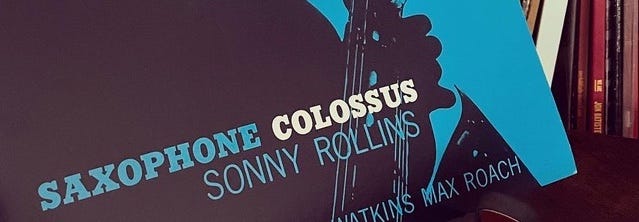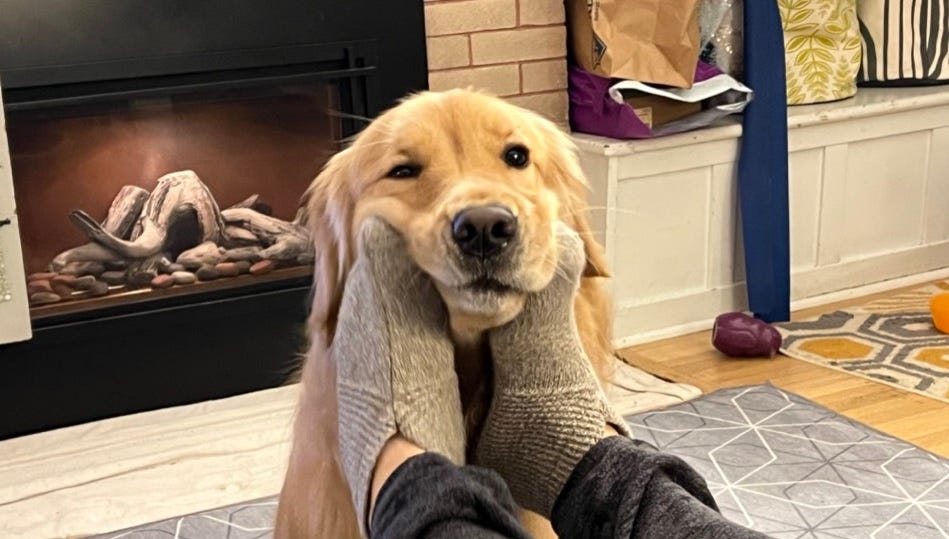

Discover more from Kirk's Notes
The older I get, the more aware I am of my own memory. I notice when it works, and when it doesn’t. How it works, and how it doesn’t. One minute, I’m unable to remember the name of a person I just met. Five minutes later, I perfectly recall a random TV actor I haven’t thought about in ten years.
Musicians talk a lot about “muscle memory.” Repeat a task often enough—say, playing a D major scale on a tenor saxophone—and you’ll eventually commit it to your muscle memory. It’s a fun turn of phrase, and it feels accurate. You run the etude/lick/exercise enough times that your finger muscles just start to remember it without requiring your brain to consciously tell them what to do. Musicians sometimes call that “getting it under your fingers.”
I’m sure everyone reading this, musician or no, has dozens of patterns stored in their fingers, quietly waiting for activation. Sometimes I watch Emily knit and I can see her fingers remembering each intricate sequence. She’s watching TV, and her hands are operating of their own accord. If you’ve ever learned to touch-type or mastered a set of keyboard shortcuts, well, there you go. It’s easy to take your own muscle memories for granted, but worth taking a moment to notice them.
Last year I made an episode of Strong Songs about great instrumental solos. I spent a big chunk of the episode focusing on one of my favorite jazz solos, saxophonist Sonny Rollins’ brilliant 1956 improvisation on “St. Thomas.” I transcribed that solo back when I was in school, which is to say I figured out the solo by ear, wrote it out, and learned to play the whole thing along with the record.
Transcription is a painstaking process; you go phrase by phrase, lick by lick, sometimes sixteenth-note by sixteenth-note. Gradually you assemble musical words, sentences, and paragraphs, repeating them slightly faster until you’re able to fluently recite the whole thing, chapter and verse.
It had been twenty years since I transcribed Sonny’s solo. When I picked up my saxophone to record some examples for Strong Songs, I found I wasn’t sure I would remember where to start. So many things had moved into and out of my mind since then! Neighborhood layouts for two major cities; keyboard shortcuts for three different music notation apps; sprawling sci-fi and fantasy lexicons; at least three new types of musical instrument. I put the horn in my mouth, pressed play on the record… and marveled as my fingers immediately began remembering where to go.
It wasn’t all there at once. I’d play a bit, then stop, pause the recording, see what felt and sounded right. But it was there, like a photograph under a layer of dust. My fingers remembered.
Sonny’s phrases on “St. Thomas” begin short and gradually elongate, eventually stretching into these multi-bar mini-compositions that travel the full range of the instrument. I grew increasingly amazed by my brilliant little fingers as they pulled those elaborate phrases seemingly out of nowhere, first haltingly, then confidently re-tracing the melodic contours they’d traced so many times. Muscle memory, like a miracle!
Video games present an unusually clear window into a similar process. As an elder millennial who grew up playing flight simulator (okay, X-Wing simulator) games on PC, I am a particular sort of gamer known as an “inverter.” When I play games with a controller (as opposed to a touchscreen or mouse and keyboard), I feel most comfortable inverting the Y-axis of the right thumbstick, which typically governs the movement of the in-game camera. I press the stick up; the camera looks down. I press it down; the camera looks up. The X-axis is not inverted; only the Y. Countless hours of gaming have etched this camera-control method onto the deepest parts of my brain.
Recently my friend Chris Plante, also an inverter, explained on his games podcast The Besties that he had recently de-programmed his mind and learned to play games like most people do, with both the X- and Y-axes moving “normally.” I was inspired to try the same method, just to see if I could do it. I’ve been at it for about a month now, and the experience has really underlined the difference between my conscious, active memory and my unconscious, “muscle” memory. (I understand there are actual scientific terms for these things, but I’m hoping you’ll forgive me for not delving into them here.)

When I’m walking around in a relaxed, exploration-focused game like Breath of the Wild or Death Stranding, I have no problem reorienting my brain to the unfamiliar, non-inverted camera controls. I do it actively, with conscious thought: “Okay, now you want to look up, and the stick moves up too, so move them together… good… okay you want to look down, move it down…” I don’t say all that out loud, so it happens pretty quickly, but that’s more or less what my brain is saying to itself.
However, when things get more exciting—when I’m thrust into a stressful situation that requires faster reactions than my conscious mind can process—it all goes out the window. Aaaaa, a zombie just lunged at me through a window! My muscle memory takes over, and the camera begins swinging like an out-of-control tetherball. Usually the zombie eats me.
Frustrating as that can be, I can already feel my old muscle memories being overwritten by the new method. At some point it will have been rewritten completely. The moment that happens, I’ll know I’ve reprogrammed a part of my brain that I can’t even consciously access. Even better, I’ll know that my brain is still capable of such a thing.
I’ve been transcribing solos again lately, this time on guitar. I’ve spent dozens of hours over the past few months working out classic solos by Jimi Hendrix (“Hey Joe”), Larry Carlton (“Kid Charlemagne”), David Gilmour (“Money”), and most recently, Wes Montgomery (“Fried Pies”). Time and again I’m struck by the pleasant mystery of the process, as I patiently teach my fingers to internalize movements that my conscious mind will soon forget.
As I enter middle age, I’ve been reminded in several small and not-so-small ways how lousy it feels when your body betrays you. Fortunately, the inverse is also true: there are few things more wonderful than when your body surprises you. Each time my muscle memory asserts itself, it’s a lovely, surprising reminder of my own capabilities. As my conscious mind peers out through its keyhole view of reality, my unconscious mind is whirring away beneath the surface, stronger and more able than I’ll ever know.
Music Recommendations
(Now with Songwhip links so you can easily go listen!)
Huntertones - Time to Play - A killin funk/jazz group with creative arrangements and some nice deep horn tones. All funk bands could use a sousaphone.
Louis Cole - Quality Over Opinion - For a while this album was basically just the video for “I’m Tight” to me - I watched it over and over and that was enough. The rest of the album is really good too, though.
Belle & Sebastian - How To Solve Our Human Problems, Parts 1-3 - Despite my obsession with 2006’s A Life Pursuit, I haven’t listened to much recent B&S. That has now changed. I love this record! I just did a bonus Patreon mini-episode of Strong Songs about one of my favorite songs, “The Girl Doesn’t Get It,” so go become a patron if you want to hear me geek out about Dm7 chords.
Her - Her - A very cool French funk duo recommended in the Strong Songs Discord listening club. Good stuff. Not to be confused with H.E.R., who is also good.
Wes Montgomery - Boss Guitar and Incredible Jazz Guitar - I’m finally a good enough guitar player to start transcribing some Wes, and what a blast it’s been. I have a whole new appreciation for his conception, and for how hard the man could swing.
Juana Molina - ANRMAL (Live in México) - This wasn’t the first of Molina’s records I heard; I actually think I included her in my recommendations last time around. A buddy of mine reminded me to listen to this one and it’s been in the rotation ever since.
Stromae - Multitude - Another one from the Strong Songs Discord. Come for the bonkers displaced groove on “Santé,” stay for every other song.
Raul Midón - State of Mind - I recently got back into Midon after watching some truly bonkers videos of him performing live, but I’ve been a fan since he performed for us back at our shared alma mater, UMiami.
Cécile McLorin Salvant - Ghost Song - I don’t actually remember who recommended this album to me, but it is wonderful. Is this what the vanguard of vocal jazz sounds like these days? Probably! Starts with a great Kate Bush cover, too.
King Gizzard & the Lizard Wizard - Changes - An approachable concept album from one of the most interesting bands going. The mix on this is unusual, particularly the drums. Oddball sound, great riffs.
Gabe Dixon - Live from Scholes Street - Another UMiami alum, Gabe has been at it for decades now, and he keeps getting better. Nice to hear Randy Schrager on drums, too. “I Believe In Our Love” is a real standout.
Lizzo - Special - Emily and I have had a great time basking in our shared love of Lizzo. “2 Be Loved (Am I Ready)” is a great example of her at her best; what a chorus! And her recent HBO concert film was the feel-good hit of the season.
Harry Chapin - Verities & Balderdash - I’ve known some of Chapin’s songs for most of my life, but had never really sat down and listened to him. After mispronouncing his name on Strong Songs, I remedied that, starting with this all-time classic record.
Completions - I Needed Help - My cellist/songwriter buddy Shawn makes music as Completions, and recently released this very cool new record. It was a lot of fun watching him put this album together, and I think you should check it out!
Al Stewart - Year of the Cat - A few people have written in to suggest that I talk about this album on Strong Songs. I’ve only just started listening to it, but dang. A justified classic, and another notch on the belt for Alan Parsons.
Nickel Creek - Celebrants - The depth of skill that went into making this record... what can you say? Their musical conception is peerless. Go listen to “The Meadow” and you’ll see what I mean. Give me a break!
Onward
I’d make some promises about being faster with my next newsletter, but I know better. I do want to write more, though. Writing is fun! Maybe I’ll finally start doing some sort of paid-tier thing here at Substack. We’ll see.
I’m still taking a break from Strong Songs, and it’s been a very good thing for me on multiple levels. I’m already getting excited to get back at it, though. Elsewhere on the internet: I’ve essentially quit Twitter but you can still find me posting occasionally on Instagram, so by all means, come by and say hi.
I’ll leave you with this photo of Appa, who loves having her jowls scritched more than any dog I’ve ever met. Seriously, she loves it so much.
Take care and keep listening -
~KH
3/31/2023
Subscribe to Kirk's Notes
A newsletter about music and other things.







